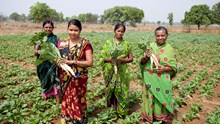
Growing concerns over water scarcity, farmers are constantly looking for smarter ways to irrigate their crops without wasting precious resources. Furrow Irrigation and Raised Bed Planting (FIRB) is an advanced agricultural technique designed to optimize water usage, improve soil health, and boost crop yields.
This method is particularly beneficial in regions facing water scarcity and soil degradation, offering a sustainable alternative to traditional flood irrigation. FIRB is gaining traction among modern farmers because it optimizes irrigation efficiency and minimizes common farming challenges like soil erosion, weed infestation, and poor drainage. Whether you’re growing wheat, maize, or other high-value crops, FIRB offers a more sustainable and productive way to farm.
What Is FIRB and How Does It Work?
At its core, FIRB is a combination of raised beds for planting crops and furrows for irrigation. Instead of flooding the entire field, water is channeled through narrow furrows between the beds, allowing controlled absorption into the soil. This setup prevents excess runoff, keeps the soil structure intact, and ensures plants get just the right amount of moisture.
By planting crops on raised beds, farmers also improve soil aeration, which leads to stronger root development and healthier plants. The structured layout makes it easier to manage weeds, reduces soil compaction, and creates an ideal growing environment for a variety of crops.
Understanding FIRB and How Does It Work?
FIRB involves planting crops on raised beds while irrigating them through furrows. Water moves horizontally from the furrows into the beds, ensuring efficient moisture distribution. This system reduces water wastage, prevents soil erosion, and enhances root development, leading to healthier crops and higher yields.
The raised beds provide better aeration and drainage, preventing waterlogging and promoting stronger root growth. The furrows act as channels for irrigation, allowing water to seep into the soil gradually rather than flooding the entire field. This controlled water distribution ensures that crops receive adequate moisture without excessive wastage.
Why FIRB Is a Game-Changer in Agriculture
Farmers worldwide are adopting FIRB because of the multiple benefits it offers. Here’s why this technique is making waves:
-
Water Conservation – FIRB uses significantly less water than conventional flood irrigation, helping farmers save resources and reduce their water bills.
-
Better Soil Health – Raised beds improve aeration, preventing waterlogging and root damage. Plus, they protect soil from erosion, keeping nutrients intact.
-
Higher Yield Potential – Since plants receive water more efficiently, FIRB enhances growth and productivity, often leading to higher-quality harvests.
-
Natural Weed & Pest Control – Drier soil on raised beds makes it harder for weeds to thrive, reducing competition for nutrients. Additionally, it lowers pest infestation risks.
-
Climate Resilience – FIRB helps farmers adapt to unpredictable weather conditions by ensuring water reaches plant roots even in dry spells.
-
Sustainability – By preventing soil erosion and conserving water, FIRB supports long-term soil health and environmental balance.
Advantages of FIRB
-
Water Conservation – FIRB significantly reduces water consumption compared to conventional irrigation methods. The furrows allow controlled water flow, minimizing runoff and evaporation.
-
Improved Soil Aeration – Raised beds enhance soil aeration, promoting better root growth and reducing the risk of waterlogging.
-
Enhanced Nutrient Uptake – The structured planting system facilitates efficient nutrient absorption, leading to improved crop health.
-
Weed and Pest Control – FIRB reduces weed infestation by limiting excess moisture, creating an unfavorable environment for pests.
-
Higher Yield Potential – Studies indicate that FIRB can increase crop yields by optimizing irrigation schedules and improving soil conditions.
-
Reduced Soil Erosion – The raised bed structure prevents soil erosion by minimizing water runoff and maintaining soil integrity.
-
Better Crop Uniformity – FIRB ensures uniform water distribution, leading to consistent crop growth and improved quality.
How to Implement FIRB on Your Farm
To successfully implement FIRB, farmers must consider:
-
Bed Dimensions – The width and height of raised beds should match the needs of your crop type and soil conditions.
-
Irrigation Scheduling – Timing is everything! Make sure you adjust water flow based on plant requirements and climate conditions.
-
Crop Selection – FIRB works well for wheat, maize, cotton, and other moisture-sensitive crops that benefit from structured irrigation.
-
Soil Preparation – Proper tilling and leveling help maintain the integrity of furrows and beds, preventing waterlogging and uneven distribution.
-
Machinery & Equipment – While FIRB can be done manually, using bed shapers and furrowers can make the process much more efficient.
Challenges and Future Prospects
While FIRB offers numerous benefits, challenges such as initial setup costs and the need for technical expertise can hinder adoption. However, with increasing awareness and support from agricultural research institutions, FIRB is gaining traction as a viable solution for sustainable farming.
Future advancements in FIRB may include precision irrigation techniques, automated furrow irrigation systems, and improved soil monitoring technologies. These innovations can further enhance the efficiency and effectiveness of FIRB, making it more accessible to farmers worldwide.
FIRB isn’t just a farming technique—it’s a sustainable solution to modern agricultural challenges. By integrating furrow irrigation with raised bed planting, farmers can boost productivity, conserve water, and improve soil health, all while reducing costs. Whether you're a smallholder farmer or managing large-scale cultivation, FIRB is a smarter way to farm with long-term benefits for both the land and the harvest.
















